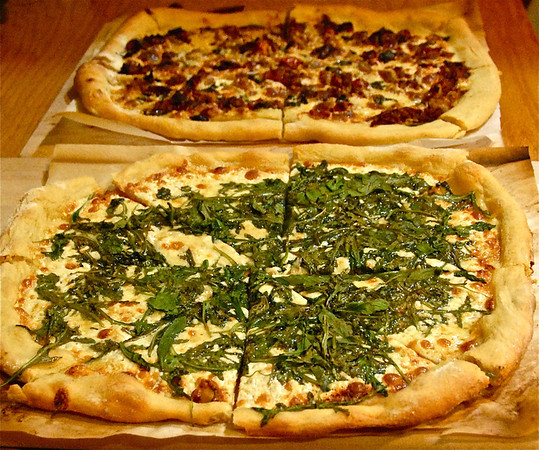
For years I had a problem with pizza. What I liked and what I ended up eating were two vastly different things. I wanted crunchy yet chewy thin crusts with fresh, flavorful toppings. What I got were gummy, limp slices with bland and greasy cheese that oozed onto my hands, shirt, jeans . . ..
Turned off by floppy, oily take-away, I periodically tried to make my own pies. While the recipes in The Joy of Cooking, Fanny Farmer and Marcella Hazan’s Essentials of Classic Italian Cooking made perfectly respectable pizzas, none resulted in the crisp, wafer-thin crust that I craved.
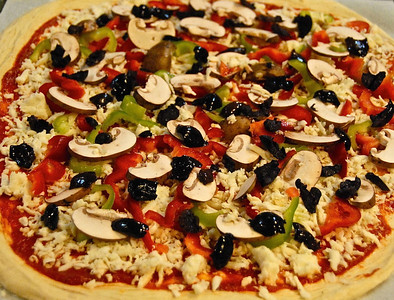
Around the time that I had resigned myself to mediocrity my husband and I had dinner at the home of our friends Rob and Brande. On that fateful night we ate Rob’s ethereal, homemade pizzas. With their firm yet light crusts, hearty sauces and fresh, wholesome toppings these pizzas ranked among the best that I’d ever consumed. With one amazing meal I rediscovered my love of this food.
After months of badgering Rob for lessons, last weekend I walked, step-by-step, through his pie-making process. Needless to say, it was a fun way for this food-lover to spend a Saturday night. It was also a great opportunity to pick up tips for fellow fledgling pizza bakers.
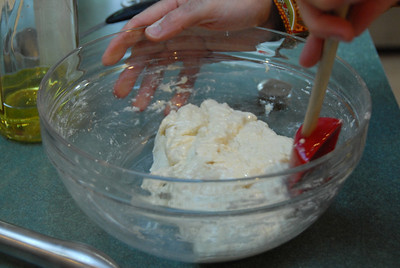
Usually recipes contain at least one ingredient that sets them apart from all others. In Rob’s case it’s vital wheat gluten. Found in the baking aisle of most grocery stores, this powdery, high protein substance bumps up the elasticity of baked goods. Want a chewier pizza? Add vital wheat gluten.
Another inside scoop pertains to parchment paper. Cut your parchment paper so that it matches the dimensions of your pizza stone. This way you don’t have paper slopping over the sides or pizza baking directly on top of the stone. How sensible!
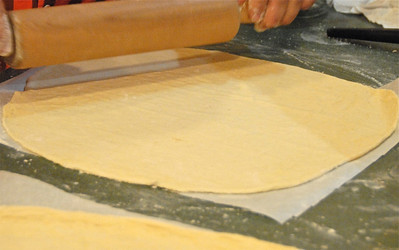
Once your dough has risen, you’ll divide it into two or three balls — the more balls you shape, the thinner the dough and resulting crust will be. Using a flour-dusted rolling pin, roll out a dough ball so that it covers the parchment. You’ll then brush the top with olive oil that has simmered alongside sliced garlic, fresh oregano and crushed red pepper. This infused oil was my husband’s favorite tip of the night. Who needs messy tomato sauce when you can slather a warm, zesty oil over the surface of your pie?
At this point you’ll add your toppings. Layer on the cheeses, veggies, meats — whatever you desire. Dough dressed, you’ll slide a pizza peel beneath your parchment paper and ease your pie into your preheated oven and onto the preheated pizza stone. Twelve to sixteen minutes later you’ll have a crisp and delectable repast.
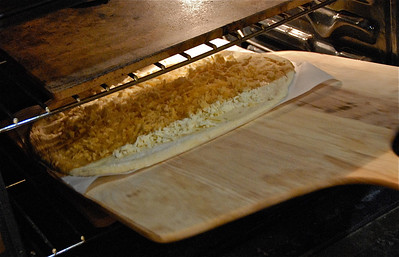
Note that, although I’d been against adding more gadgets to my already overstocked kitchen, I am quite pleased with the acquisitions of pizza peel and stone. How else could I have gotten my pies into and out of the oven without dropping them on the tile floor, oven door or fat cat who lingers on the floor by the oven door? Likewise, how could I have gotten them to cook evenly and completely? I couldn’t have.
ROBBIE P’S PIZZA DOUGH
Makes 2 to 3 (8-slice) pizzas
2 1/2 generous cups all-purpose flour
1/2 generous cup cornmeal
pinch kosher salt
1 tablespoon vital wheat gluten
2 generous teaspoons dry active yeast
1/4 teaspoon honey
2 cups lukewarm water
2 1/2 teaspoons olive oil, plus more for greasing hands
In a large bowl whisk together the flour, cornmeal, salt and vital wheat gluten.
In a separate bowl mix together the yeast and honey. Add the water to the yeast and honey and stir to combine. Pour almost all of the water into the flour mixture. Stir to combine. If the dough seems too dry, add the rest of the water and stir again. Add the olive oil, stir, and cover the bowl with cling wrap.
Place the bowl in a warm spot and allow the dough to rise for a minimum of 3 hours. (Note that the dough can be made a day in advance. Once the dough has risen, divide it into 2 to 3 balls, place each in a well-oiled bowl, cover and refrigerate.)
Cut two to three sheets of parchment paper to match the size of your pizza stone.
Preheat your oven to 550 degrees Fahrenheit.
Once the dough has risen, remove the cling wrap. Place a small mound of flour onto a sheet of cut parchment paper.
Rub some olive oil on your hands. Remove the dough from the bowl and divide it into two or three equal parts. Place the remaining dough into 1 or 2 oiled bowls and set aside.
Fold the dough several times and then make it into a ball. Put the ball on top of the flour and, using your hands and flipping it over and over, shape it into a square. (If you have a round pizza stone, you’ll shape it into a circle.)
Roll out the dough until it’s the shape and size of the parchment paper. Crimp the edges all the way around and then brush olive oil over the top.
From here you’ll layer sauce and/or cheese, vegetables, meats, etc. onto the pizza. Bake at 550 degrees Fahrenheit for 12 to 16 minutes, checking periodically to ensure that the pizza doesn’t overcook. Remove and serve hot.